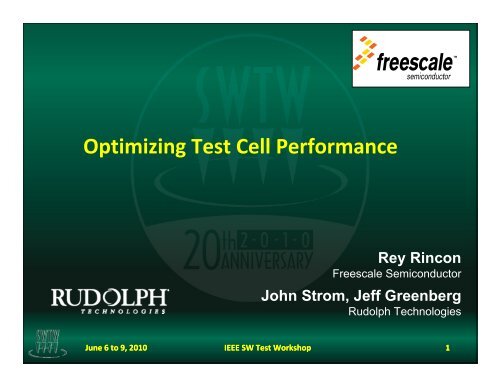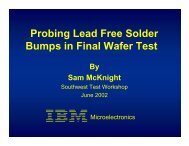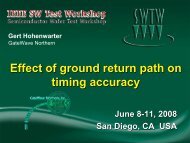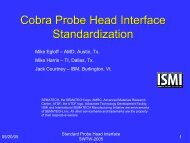Optimizing Test Cell Performance Using Probing Process Analysis ...
Optimizing Test Cell Performance Using Probing Process Analysis ...
Optimizing Test Cell Performance Using Probing Process Analysis ...
Create successful ePaper yourself
Turn your PDF publications into a flip-book with our unique Google optimized e-Paper software.
TM<br />
<strong>Optimizing</strong> <strong>Test</strong> <strong>Cell</strong> <strong>Performance</strong><br />
Rey Rincon<br />
Freescale Semiconductor<br />
John Strom, Jeff Greenberg<br />
Rudolph Technologies<br />
June 6 to 9, 2010 IEEE SW <strong>Test</strong> Workshop 1
Problem Statement<br />
• How are we going to optimize <strong>Test</strong> <strong>Cell</strong><br />
performance?<br />
– Investigate Prober performance<br />
– Investigate Probe Card performance<br />
– Investigate Probe Card Analyzer correlation to <strong>Test</strong> <strong>Cell</strong><br />
June 6 to 9, 2010 IEEE SW <strong>Test</strong> Workshop 2
• Pass1<br />
Design Of Experiment<br />
– Measure/Adjust probe card on PrecisionPoint® VX3<br />
– Probe wafers<br />
– Inspect probe marks with NSX® after probing<br />
– Measure <strong>Probing</strong> <strong>Process</strong> performance with WaferWoRx® on NSX<br />
– Compute VX3 correlation to scrub marks<br />
PMI data<br />
June 6 to 9, 2010 IEEE SW <strong>Test</strong> Workshop 3
• Pass2<br />
Design Of Experiment<br />
– Adjust Probe Card on PrecisionWoRx® VX4 using “Predictive Scrub”<br />
– Probe wafers<br />
– Inspect probe marks with NSX after probing<br />
– Measure <strong>Probing</strong> <strong>Process</strong> performance improvements with<br />
WaferWoRx on NSX<br />
Pass1 WWX info<br />
PMI data<br />
June 6 to 9, 2010 IEEE SW <strong>Test</strong> Workshop 4
Pass1: Measure/Adjust probe card on VX3<br />
• VX3 data shows probe’s center of scrub is<br />
within spec and nominally centered on the pad<br />
June 6 to 9, 2010 IEEE SW <strong>Test</strong> Workshop 5
Pass1: Probe Wafers<br />
• 200mm wafer<br />
• 378 Touchdowns<br />
• Cantilever probe card (4 X 1)<br />
• 700+ probes<br />
• Two tiers (different tip lengths) 1<br />
Strom, “Multi-tier Probe Cards and Contact Resistance, SWTW 1998 1<br />
Strom, A Study of <strong>Probing</strong> <strong>Process</strong> <strong>Analysis</strong>, SWTW 1999 1<br />
June 6 to 9, 2010 IEEE SW <strong>Test</strong> Workshop 6
Pass1: PMI Results<br />
Need some raw PMI data here<br />
June 6 to 9, 2010 IEEE SW <strong>Test</strong> Workshop 7
Pass1: <strong>Probing</strong> <strong>Process</strong> <strong>Analysis</strong> Overview<br />
• PMI raw scrub mark data is input<br />
• Prober, Probe to Pad Alignment (PTPA) and Probe Card<br />
performance is calculated<br />
• <strong>Process</strong> performance is determined from combined Prober and<br />
Probe Card performance<br />
Prober and PTPA<br />
<strong>Performance</strong><br />
Raw Scrub Data<br />
<strong>Probing</strong> <strong>Process</strong><br />
<strong>Performance</strong><br />
Probe Card<br />
<strong>Performance</strong><br />
June 6 to 9, 2010 IEEE SW <strong>Test</strong> Workshop 8
Pass1: <strong>Probing</strong> <strong>Process</strong> <strong>Performance</strong> Summary<br />
• <strong>Process</strong> Length issues<br />
• Pad Size = 60 microns and the <strong>Process</strong> Length = 48 microns<br />
• Single Wafer CPK ~ 1.25<br />
• Probe Card is the major error source<br />
• Prober error contribution relatively small compared to Probe Card error<br />
June 6 to 9, 2010 IEEE SW <strong>Test</strong> Workshop 9
Pass1: Prober <strong>Performance</strong> Summary<br />
• Overall prober error ~= 12 microns<br />
• Probe to Pad Alignment larger than normal (~5 microns)<br />
• Deflection/Translation under load relatively large for just 800<br />
pins – may be problematic with higher load probe cards<br />
• Small Orthogonality and Scaling errors in stage motion<br />
June 6 to 9, 2010 IEEE SW <strong>Test</strong> Workshop 10
Pass1: Probe Card <strong>Performance</strong><br />
• No XY scaling errors<br />
• Good repeatability<br />
• Scrub Length and Width typical for a cantilever probe card<br />
• Probe Card Length Accuracy is the major error source (10 microns)<br />
June 6 to 9, 2010 IEEE SW <strong>Test</strong> Workshop 11
Pass1: Probe Card SuperPad View<br />
Top row only<br />
• Probes are scrubbing short of pad center<br />
• Different tiers have different offsets<br />
Bottom row only<br />
June 6 to 9, 2010 IEEE SW <strong>Test</strong> Workshop 12
Pass1: Probe Card Scrub Length and Scrub Width<br />
Color Coded for Scrub Length<br />
Color Coded for Scrub Width<br />
Tier1<br />
Tier1<br />
Tier2<br />
Tier2<br />
• Interleaved tiers have different scrub characteristics<br />
• Tier1: Shorter tip lengths = long and thin scrubs<br />
• Tier2: Longer tip lengths = short and wide scrubs<br />
June 6 to 9, 2010 IEEE SW <strong>Test</strong> Workshop 14
Pass1: Probe Card <strong>Performance</strong> Summary<br />
•Pros<br />
• Probe positions show no XY scaling error<br />
• Probes positions (scrub marks) are repeatable<br />
• Cons<br />
• Probes are scrubbing short of the pad center<br />
• Multiple tiers/tip lengths each have different<br />
scrub characteristics<br />
• Long Tip Length: Short wider scrub<br />
• Short Tip Length: Long thin scrub<br />
• Can not resolve by simply changing overtravel<br />
• Probe card performance problems consume major part<br />
of pad<br />
June 6 to 9, 2010 IEEE SW <strong>Test</strong> Workshop 15
Probe Card Analyzer to <strong>Test</strong><br />
<strong>Cell</strong> Correlation <strong>Analysis</strong><br />
June 6 to 9, 2010 IEEE SW <strong>Test</strong> Workshop 16
Pass1: <strong>Test</strong> <strong>Cell</strong> vs. VX3 Probe Card Correlation<br />
VX3<br />
WWX Alignment Errors – Vector View<br />
• VX3 measures probe center of scrub ~= center of pad<br />
• WaferWoRx shows probes scrubbing short of pad center<br />
Vector pointing to<br />
the right = scrub<br />
center is to the<br />
right of pad center<br />
June 6 to 9, 2010 IEEE SW <strong>Test</strong> Workshop 17
Pass1: <strong>Test</strong> <strong>Cell</strong> vs. VX3 Probe Position – Absolute<br />
Probe Relative analysis<br />
Width Axis<br />
Length Axis<br />
VX3<br />
WWX<br />
June 6 to 9, 2010 IEEE SW <strong>Test</strong> Workshop 18
Review Cantilever Probe Scrub Properties<br />
on PCA Measurement Window vs. on Bond Pad<br />
Short tip<br />
length<br />
Long tip<br />
length<br />
Short tip<br />
length<br />
Long tip<br />
length<br />
PCA Window – Low Friction<br />
• Minimal probe tip deflection<br />
because friction is low<br />
• Scrub length increases with<br />
tip length<br />
Aluminum Bond Pad – High Friction<br />
• Significant probe tip deflection<br />
because friction is high<br />
• Longer tip lengths scrub shorter<br />
due to higher deflection<br />
• Shorter tip lengths scrub longer due<br />
to lower deflection<br />
June 6 to 9, 2010 IEEE SW <strong>Test</strong> Workshop 19
Pass1: <strong>Test</strong> <strong>Cell</strong> to VX3 Correlation ‐ Summary<br />
• Good correlation in “Width” axis between VX3<br />
and WaferWoRx data<br />
• VX3 is accurately representing the initial contact<br />
position of the probe<br />
• Correlation issue in the “Length” axis<br />
• Losing ~ 10 microns of scrub position due to<br />
cantilever probe scrub characteristic differences on<br />
hard surface vs. aluminized pad<br />
Length Axis<br />
VX3<br />
Width Axis<br />
Initial probe<br />
contact<br />
position<br />
WWX<br />
June 6 to 9, 2010 IEEE SW <strong>Test</strong> Workshop 20
<strong>Process</strong> Improvement Opportunities<br />
Prober Improvement<br />
• Probe to Pad Alignment Improvements (Yaw and X Offset)<br />
• <strong>Process</strong> improvement available ~5 microns<br />
Probe Card Improvement<br />
• Use VX4 “Predictive Scrub” during card adjustment<br />
• <strong>Process</strong> improvement available ~10 microns<br />
June 6 to 9, 2010 IEEE SW <strong>Test</strong> Workshop 21
“Predictive Scrub”<br />
June 6 to 9, 2010 IEEE SW <strong>Test</strong> Workshop 22
Predictive Scrub<br />
1) PCA measurement<br />
PCA Overtravel Position<br />
2) WaferWoRx Probe Card<br />
measurement from PMI data<br />
3) Quantify differences<br />
between PCA and <strong>Test</strong> <strong>Cell</strong><br />
4) Measure Predictive Scrub<br />
with VX4<br />
+<br />
+<br />
+<br />
PCA Predicted<br />
Overtravel Position<br />
PCA Center of Scrub<br />
PCA Predicted<br />
Center of Scrub<br />
PCA No OT Position<br />
PCA standard<br />
measurement<br />
WaferWoRx<br />
measurement<br />
PCA Predicted Scrub<br />
Measurement<br />
June 6 to 9, 2010 IEEE SW <strong>Test</strong> Workshop 23
Pass 2: Measure Probe Card on VX4 Before and After Adjust<br />
“Measured”<br />
Center of Scrub Positions<br />
Before Adjust<br />
“Predicted”<br />
Center of Scrub Positions<br />
Before Adjust<br />
“Predicted”<br />
Center of Scrub Positions<br />
After Adjust<br />
Apply<br />
SCF<br />
• VX4 Results BEFORE adjusting probe positions<br />
• Measured positions are well centered<br />
• Predicted positions have a donut hole of probes scrubbing short of center<br />
• VX4 Results AFTER adjusting probe positions based on<br />
Predicted Positions<br />
• Predicted positions are now well centered<br />
June 6 to 9, 2010 IEEE SW <strong>Test</strong> Workshop 24
Pass 2: Measure <strong>Process</strong> Improvements<br />
Card Accuracy Error = 10 microns<br />
Pass1 Results<br />
Card Accuracy Error = 4 microns<br />
Pass2 Results<br />
June 6 to 9, 2010 IEEE SW <strong>Test</strong> Workshop 25
Pass 2: Probe Card <strong>Performance</strong> Details<br />
Pass1 WaferWoRx Results<br />
Need new vector plot #7<br />
Pass2 WaferWoRx Results<br />
• Probes scrubbing short of pad center for Pass1 data<br />
• Probes are well centered for Pass2 data<br />
• Probe Card was adjusted using VX4 “Predictive Scrub”<br />
June 6 to 9, 2010 IEEE SW <strong>Test</strong> Workshop 26
Pass 2: VX4 “Predictive Scrub” Correlation to <strong>Test</strong> <strong>Cell</strong><br />
Pass1<br />
Correlation<br />
VX4 “Predicted” vs WWX – Length” probe position<br />
VX4<br />
Pass2<br />
Correlation<br />
June 6 to 9, 2010 IEEE SW <strong>Test</strong> Workshop 27
Summary<br />
• We were able to improve <strong>Test</strong> <strong>Cell</strong> performance!<br />
• CPK improvements<br />
– Pass1 CPK = 1.25, <strong>Process</strong> Length = 48 microns<br />
– Pass2 CPK = 1.45, <strong>Process</strong> Length = 41.3 microns<br />
• Probe Card <strong>Performance</strong> improvements by adjusting<br />
probe positions based on VX4 “Predictive Scrub”<br />
– Pass1 Length Accuracy Error = 10 microns<br />
– Pass2 Length Accuracy Error = 4 microns<br />
• Improved Probe Card Analyzer correlation to <strong>Test</strong> <strong>Cell</strong><br />
using VX4 “Predictive Scrub”<br />
• Identified Prober Stage and PTPA Errors with<br />
WaferWoRx on NSX <strong>Probing</strong> <strong>Process</strong> <strong>Analysis</strong><br />
– Additional performance improvement available to pursue<br />
June 6 to 9, 2010 IEEE SW <strong>Test</strong> Workshop 28
Acknowledgements<br />
Freescale Semiconductor<br />
John Vanderbilt, Greg Faulkner, Devin Sheridan<br />
Rudolph Technologies<br />
Darren James, Rod Doe, WooYoung Han<br />
JEM<br />
Patrick Mui<br />
Other Contributors<br />
Fred Megna, Kajiwara “Kaji” Kunitomo<br />
June 6 to 9, 2010 IEEE SW <strong>Test</strong> Workshop 29









